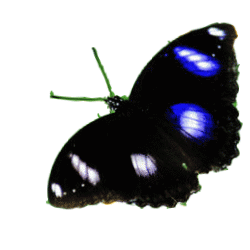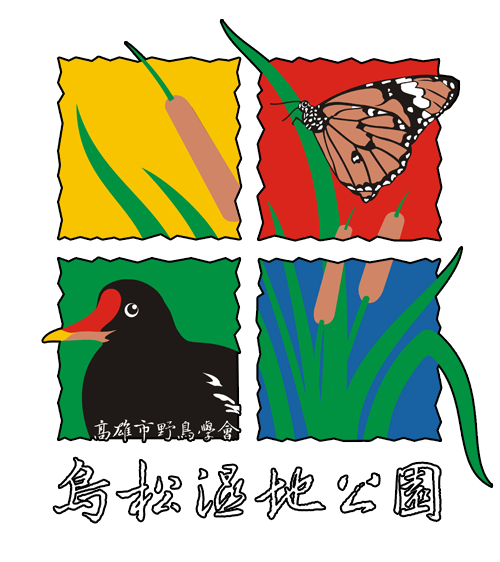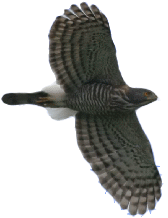Tips on Observing Niaosong Wetland Park Ecology
Guidelines of Observing Wetlands
- Respecting Nature.
- Keeping quiet and keeping the voice down.
- Taking nothing except pictures from the Park; releasing the insects after observing them.
- Leaving nothing except your footprints, remembering to take away your belongings (including the garbage).
- No fishing or carelessly releasing any creatures, for fear of endangering local ecology.
- No bikes or motorcycles on the Wooden Trail.
- No interrupting or interfering birds in breeding seasons or in the nests.
- Forming a good habit of taking notes anytime anywhere.
Main Gate area: Fences of large-leaved banyans and Formosan beautyberries, when the fruits are ripening, attract birds like Chinese bulbuls, Japanese white-eyes, black-naped blue monarchs, treepies, and Muller's barbets to come for feeding. Little woodpeckers are often seen in the white albizias by the cabins.
Settling Basin area: Chinese tallow trees are regular dwellers here. Ripening fruit in fall draws hoards of treepies to forage. Panama berries are Chinese bulbuls’ favorite. Pond banks below the woods serve as the feeding and drinking places. White wagtails stop and go, foraging at the Gate Square.
Small Pond area: Duck Watching Platform is the most-often visited spot by visitors, who can have a look at mallards and common moorhens swimming happily in the Pond. Common moorhens mainly gather in the Settling Basin and the Small pond. Each couple of common moorhens have their exclusive territory to ensure that food is enough. Besides, gorgeous fish catchers—common kingfishers—are often seen here.
Big Pond area: This area has the best birding condition, in which two small isles function as the habitats of two camouflage experts-- cinnamon bitterns and yellow bitterns. Yellow-bellied prinias and tawny-flanked prinias are often seen to dance among bankside water willows and bamboo reed shrubs. Japanese white-eyes and Arctic warblera often stop and forage in the pistache trees along the easternside trails. At the southeastern corner, across from the road is a lemon eucalyptus woods with Japanese white-eyes hopping up and down joyfully in the crown canopies. When the fruit trees inside the water plant dormitory are in bloom, black-naped blue monarchs and Japanese white-eyes are drawn to the places with food for them.
Instruction Pond area and Planting Reserved area: They are next to each other. The representative plants are Chinaberry trees and Taiwan acacias. In full bloom in wintertime, Chinaberry trees always attract groups of Chinese bulbuls to come to have their share of food. Dense woods are black-naped blue monarchs’ and Arctic warblers’ favorite. If lucky enough, visitors will come across American orioles coming from Cheng Ching Lake. Aquatic plants and underbrush in the Ponds are places for yellow-bellied prinias and plain prinias to take shelter and shuttle back and forth.
Tips on Observing Birds
- Common moorhens always hide in the water or between grass by the pools or ponds; while Pacific swallows and greater striated swallows often low over the Ponds.
- By the Bid Pond banks or the Ecological Isle, little Egrets, yellow bitterns, cinnamon bitterns, and black-crowned night herons forage or take their rests there.
- Scaly-breasted munias, wren warblers, and sparrows frequently move back and forth in the breeze-flown weeds straws.
- Common Kingfishers may perch on bamboos and tree branches by the Ponds, waiting for small fish to show up from under the water.
- Chinese bulbuls and red turtle doves are frequent visitors on the branches of arbors.
Tips on Observing Plants
- Knowing something about the aquatic plants in the Park is important. What is growing on the surface (floating plants)? What is growing at the waterside (emergent plants)? And what is on the shore (hygrophytes)?
- Gently stroking the tree boughs and leaves and smelling their scents, visitors can get a feel of their differences. But some plant stems, like sensitive plants, giant sensitive plants, and perforate fleeceflowers, are thorny. Visitors should be careful.
- Most stems of the sedge plants are triangle in shape. Have a touch of the umbrella plants and see what it differs from the stems of Guinea grass (gramineous plants)?
- Making a comparison of the leaves of Chinese tallow trees, elephant's ears and wild morning-glories to see whose leaves are heart-shaped, shield-shaped, or diamond-shaped.
- Learning how to differentiate the flowers, fruits, and leaves between fan palms and California Washington palms.
Tips on Observing Insects
- Paying attention to small objects moving on the water surface and stems of aquatic plants, you can see many aquatic insects moving about there.
- Bees and butterflies are busy gathering honey in flowering shrubs.
- Insects like adybugs, stinkbugs, Amata perixanthias, and longhorned grasshoppers often visit blades of wild grass.
- On the leaves of Chinese tallow trees you can usually see larvaes and cocoons of slugs and moths. Don’t touch them. They are poisonous.
- The best time of watchign cicadas is in summer. Listeing for chirping of cicadsas to locate the exact dwelling trunks.
Tips on Observing Amphibians and Reptiles
- On grasslands and bare lands along either side of the Wooden Trail, you can often see common sun skinks and long-tailed skinks sunbathing there. And on the wooden stakes, maybe you are lucky enough to find the images of sun-loving Chinese stripe-necked turtle and red-eared sliders.
- Swinhoe's japaluras, excellent tree climbers, can often be spotted in the trees. They are unique lizard species to Taiwan. They have a different way of sunbathing, hiding under the leaves, seldom exposing under the sun.
- Naturally clustered wild grass is often occupied by snakes. Don’t do in randomly.
- When stopping at the Gate Plaza or strolling along the Wooden Trail, see if you can catch the barking-like sound of Gunther's Amoy frogs.
- Night time is the best occasion of observing frogs. However, don’t touch them if you are wearing mosquito repellent, which could kill them.
Source of Information: Integrated from Ecological Illustrations of Niaosong Wetland Park



















